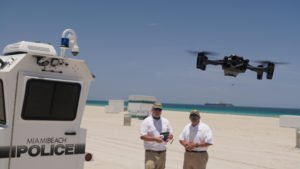In a narrowly focused and carefully crafted survey, almost 300 U.S.-based, law enforcement, fire and emergency services personnel answered some critical questions about how public safety drone programs in the AIRT and DRONERESPONDERS Spring 2020 Public Safety UAS Survey. In a media briefing this morning, Christopher Todd, Executive Director of the Airborne International Response Team (AIRT) and Chief Charles Werner (ret.), Director of DRONERESPONDERS, revealed what actual members of the public safety community at the local and state level are thinking about the drone programs in their department.
“We’re trying to do this to continually learn where we are in the drone industry,” says Werner. “We’re trying to keep improving the services we offer.” Despite headwinds caused by COVID-19, legislative proposals, and a lack of funding, public safety is a growing sector for the drone industry. More agencies are doing more with drone technology.
More than half of the public safety personnel responding said that their drone programs are now more than a year old, but the use of drones is still limited – most departments (about 59%) are still only flying 1-5 missions per month. Comparison with the fall survey, however, shows that the number is on the rise – and the variety of missions and applications is growing. More than 80% of responders use drones for training and exercises in their departments: and more than 50% use drones to acquire live stream data for incident command and control. Departments are also using drone technology for crime scene investigation, target search, forensic documentation – and interestingly, survey responses indicate cooperation between police and fire agencies when it comes to drone missions.
Here are answers to a few of the other critical questions that the survey asked.
How are public safety agencies funding their drone programs?
Unfortunately, most public safety agency drone programs are operating on a shoestring. A stunning percentage – greater than 60% – of public safety agencies are operating on less than $10,000 per year: about 23% are operating a drone program on less than $1,000.
“It’s why we see equipment like the ANAFI or the Mavic Air getting a lot of play,” says Todd. “They’re reliable and they are relatively inexpensive: they are much more accessible to these programs.”
More than 60% of the survey participants said that grant programs or donations were extremely important to their programs. Werner says that having participated in the grant process, he believes that the majority of those grant programs involve federal funding – either Homeland Security or FEMA – that passes through state programs.
Despite budget limitations, a healthy percentage of respondents – almost 30% – still plan to purchase new hardware before the end of the 2020 calendar year.
What Drones are Public Safety Agencies Using?
When it comes to hardware, the survey revealed a few significant trends. Unsurprisingly, the vast majority of drones in the public safety fleet are DJI – more than 90% of responders said that their program incudes DJI drones. But in a sector that is tight on money and holds on to hardware as long as it works – some departments are still flying 3DR Solos, even though they are no longer manufactured – newcomer Skydio has made its mark. Only 9 months after Skydio 2 came out, 11% of respondents say they are flying Skydio hardware.
That’s because of Skydio’s functionality, not necessarily because they’re a U.S.-based company, says Charles Werner. “In my personal opinion, people purchase because of the sense and avoid technolgoy – the U.S. manufacturing was just icing on the cake,” he says.
Public Safety Operations and Flight Beyond Visual Line of Sight
Flight beyond visual line of sight (BVLOS) has been a hot topic in the drone industry for a long time. More than 75% of survey responders say that flight BVLOS would be useful for their operations.
While most people think of BVLOS flight in terms of distance, for applications like pipeline inspections, “In public safety, beyond visual line of sight could have a totally different connotation,” says Todd. “It could be a fire department needing to fly around the back of a house, or a police department in an active shooter situation needing to fly around a corner.”
Is the FAA meeting the needs of public safety drone programs?
In a very encouraging shift, most responders feel that the FAA is doing a good job meeting the needs of public safety programs – and the responses have improved since the Fall survey.
Werner explains that the FAA has improved some very important and significant processes for the sector, including SGI (Special Government Interests) flight permissions- formerly called E-COAs, or Emergency COAs. This situation may arise when a public safety agency operating within the 5 mile limits of a public airport needs to fly a drone mission on an emergency basis. “We’ve been able to get permissions to fly within minutes – and they handle deconfliction within that airspace,” says Werner. The shift represents hard work on the part of the FAA to support public safety missions, particularly significant in light of the current COVID-19 crisis.
Overall, the news is good. Despite COVID-19, funding issues, and politics, public safety agencies continue to adopt drone technology. “In our assessments, public agency drone programs are growing,” says Todd. “However, [agencies] are continuing to have to bootstrap their programs.”
Miriam McNabb is the Editor-in-Chief of DRONELIFE and CEO of JobForDrones, a professional drone services marketplace, and a fascinated observer of the emerging drone industry and the regulatory environment for drones. Miriam has penned over 3,000 articles focused on the commercial drone space and is an international speaker and recognized figure in the industry. Miriam has a degree from the University of Chicago and over 20 years of experience in high tech sales and marketing for new technologies.
For drone industry consulting or writing, Email Miriam.
TWITTER:@spaldingbarker
Subscribe to DroneLife here.
https://dronelife.com/2020/07/13/public-safety-drone-programs/
 Unmanned Aerial Vehicle The latest drone news
Unmanned Aerial Vehicle The latest drone news




